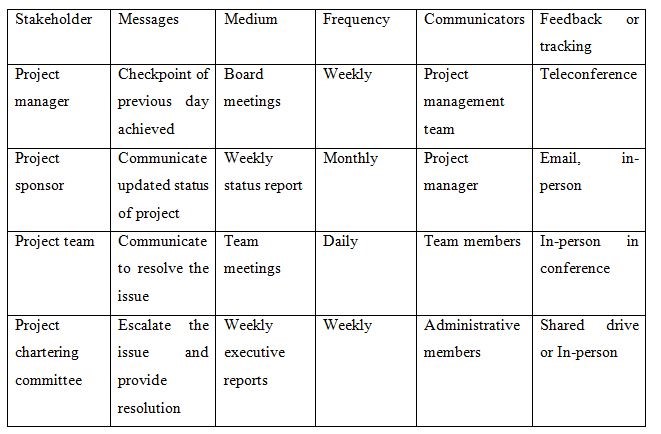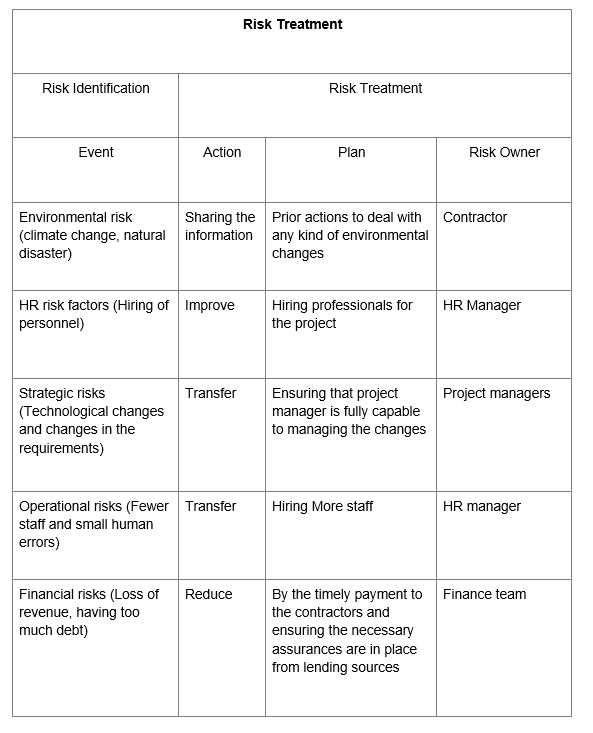Risk Management Plan of Creative Petroleum Construction
Deliverables for Stage 1A: The following are some of the main components of the Stage 1A report:
- Introduction
- Objectives
- Risk Management methodology adopted
- Detailed Investigation
- Establish the context - internal and external
- Risk Assessment:
- Risk Identification
- Risk Analysis
- Risk Evaluation
- Risk Register
Stage 2A Deliverables: In Stage 2A, the team will have created a Risk Management Plan as well as a final report incorporating Stages 1 and 2. The below are some of the main components of a Risk Management Plan:
- Executive Summary
- Table of Content
- Introduction
- Aim/Objectives
- Risk Management methodology
- Establishing the context – internal and external
- Risk Assessment – Identification, analysis and evaluation
- Tools and techniques employed
- Risk Treatment Schedule and Plan
- Risk Action Plan
- Discussion and recommendations
- Conclusion
- Appendix – Risk Register, Stakeholder Register, Risk Matrixes etc
Answer
Because of the volatile world, the construction industry is full of threats and dangers. It is important to ensure the employees' safety when working on the project. The implementation of a proper risk management strategy is critical to the project's progress. The aim of this report is to develop a risk management strategy for the CPC construction project. The risk assessment method is used in the study to identify possible threats in the programs. Risk analysis is further divided into three steps: risk recognition, risk interpretation, and risk assessment. In addition, for successful risk management, a risk evaluation and action plan are provided.
Introduction: Risk control is a concept that is now being used by a variety of companies in order to reduce the effects of risks in the workplace. In today's dynamic market climate, a company's ability to enforce safety practices in the manufacturing process is critical. The application of risk control in the building industry is critical for worker welfare.
The report's main goal is to incorporate a risk assessment mechanism in the CPC construction project and deal with future threats in a variety of scenarios. In basic terms, the report's main goal is to implement risk control procedures using appropriate methods and strategies. The below is a list of the report's goals:
- The analyze the specific risks and hazards in the construction projects for the project of CPC,
- To develop the risk management plan to deal with the potential risks,
- To develop the model within the organization so that the process of management of potential risks can be explained.
Internal risk
HR risk- CPC construction project can face the risks related to HR practices as effective workforce planning and conducting training session effectively is not an easy task for HR. so, risk can be related to HR factors in terms of recruitment and selection process.
External risk
Environmental risk- The CPC construction project has to face external risks in terms of climate change, natural disaster, water quality issue, and change in the environmental regulations. The climate change and sudden changes in weather conations can be the cause of disruption in supply of necessary resources and enhanced labor demands (Fiorino, 2010).
Risk management methodology: The risk management plan basically includes various activities or planned actions affecting the results and outcomes of the project in order to ensure the low level of impact of risk. Every project should an effective plan to manage the risk and achieve the success. The efficient risk management would allow the project team to analyze the level of risk and deal with them. The process of the risk management is given below:

The analysis of potential risks would be done with the specific period of time. The project team needs to have regular updates by the risk matrix so that the risk management process can be monitored effectively. By the risk matrix, possible risks
can be assessed and quantified in an effective way. The process of risk management includes:
● Identification of risk,
● Assessing the risk in project,
● Reassess the risks by controls,
● Treat the risk,
● Monitoring the risk, and
● Report the movement of the risk
Roles and responsibilities: Person managing the risk plan has some roles and responsibilities and those are as follows:
● Embed the risk statement and risk limits in to the activities of management so that risk can be managed effectively,
● Act on timely manner to manage and deal with the identified risk,
● Ensure that the employees have effective process to identify, measure, monitor and report the risk profile on continuous basis,
● Develop an appropriate risk management plan to meet the needs of the projects
Funding and timings: For an effective risk management plan, funds will be needed. The budget for proper risk management is as follows:

Risk categories: The key objective of the process of risk category analysis is to analyze the potential risks on the basis of project that can enhance, delay or degrade the progress of the projects. For the CPC construction project, some of
the risks are strategic risks i.e. technological changes and other business risks, operational risks like fewer staff and human errors and financial changes like large amount of credit and financial loss (Hopkin, 2017).
Stakeholders’ appetite: The project must be engaged with all the stakeholders in order to ensure the risk managing activities. All the stakeholders must be considered while setting risk appetite. For this process, there are some steps:
● Obtain all the risk register for the project,
● Sort the risk in the sequence of high to low,
● Determine from stakeholders how much risk taking capacity the project has,
● Formalize the result by the risk appetite of the project
Reporting format- communication and Tracking: The process of communication and tracking of risk management plan with the key stakeholders is given below:

Risk treatment schedule and plan: Treatment of the identified risk includes various ranges of options to manage the risk in the project of CPC, analysis of the options and then develop and execution of these actions. To minimize the potential
risks in the CPC construction project, it is important to implement the risk treatment schedule and plan in the effective manner (Miller & Bromiley, 2010). Risk treatment will be done in the risk register which is given in the appendix part.
Risk action plan: For eliminating the impact of potential risks on the CPC construction project, risk action plan is necessary to implement by the responsible team. It is analyzed that there are five major risks i.e. environmental
risk, HR risk factors, Strategic risks, Operational risks and financial risks that can be harmful for the success of the project. In the appendix part, a proper risk action plan for the CPC construction project is given (Forostenko, 2014).
Discussion and recommendation : The process of risk management is a very crucial part of the successful project. In the CPC construction project, key risks are Environmental risk (climate change, natural disaster), HR risk factors
(Hiring of personnel), Strategic risks (Technological changes and changes in the requirements), Operational risks (Fewer staff and small human errors), and Financial risks (Loss of revenue, having too much debt) and for this, the action plan
is given. Based on the above discussion, some recommendations can be given for the success of the CPC construction project.
● For good risk assessment, the project management team should concentrate on risk response preparation,
● The project consultant should evaluate different opportunities in the enterprise and develop a risk assessment strategy to address these possible threats. HR administrators should hold staff preparation exercises so that they are aware
of the project's risks.
● By accurately communicating the obligations of the responsible party, the project team will concentrate on improving risk intelligence.
Risk Analysis (Risk matrix)



Risk action plan
